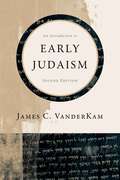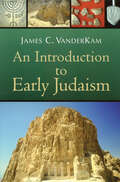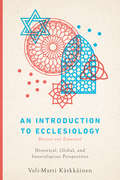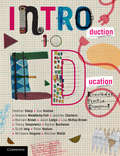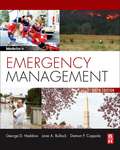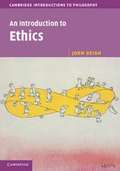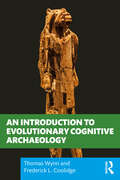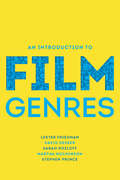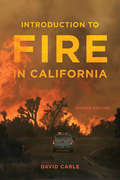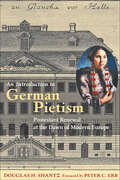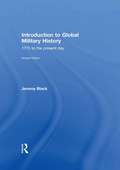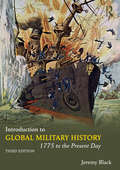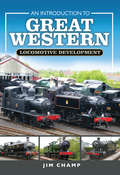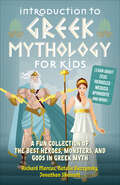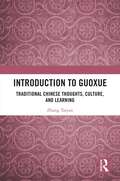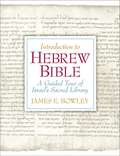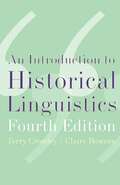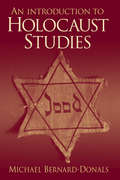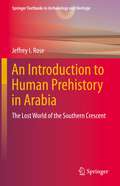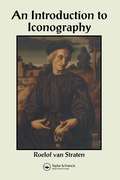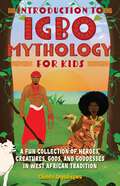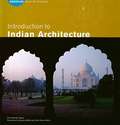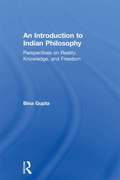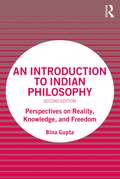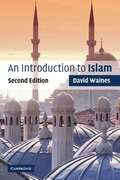- Table View
- List View
An Introduction to Early Judaism
by James C. VanderkamBased on the best archaeological research, this volume explores the history of Judaism during the Second Temple period (516 BCE–70 CE), describing the body of Jewish literature written during these centuries and the most important groups, institutions, and practices of the time. Particularly interesting are VanderKam’s depiction of events associated with Masada and, more briefly, the Bar Kokhba revolt—as well as his commentary on texts unearthed in places like Elephantine and Qumran. <p><p> Now in its second edition, with additional material and updated throughout, this book remains the preeminent guide to early Judaism for anyone looking for a text that is concise and accessible while still comprehensive—and written by one of the foremost experts in the field.
An Introduction to Early Judaism
by James C. VanderkamOne of today's most respected scholars of biblical history and the Dead Sea Scrolls, James C. VanderKam here offers a superb new introduction to early Judaism.Based on the best, most recent archaeological research, this illustrated volume explores the history of Judaism during the Second Temple period (516 B.C.E. - 70 C.E.), describing the body of Jewish literature written during these centuries and the most important groups, institutions, and practices of the time. Particularly interesting are VanderKam's depiction of events associated with Masada and the Kokhba revolt, and his commentary on texts unearthed in places like Elephantine, Egypt, and Qumran.Written in the same accessible style as VanderKam's widely praised Dead Sea Scrolls Today, this volume provides the finest classroom introduction to early Judaism available.
An Introduction to Ecclesiology: Historical, Global, and Interreligious Perspectives
by Veli-Matti Kärkkäinenmajor theological traditions, including Eastern Orthodox, Roman Catholic, Reformed, and Pentecostalecclesiological insights from Latin American, Africa, and Asiadistinct perspectives from women, African Americans, and recent trends in the United Stateskey elements of the church such as mission, governance, worship, and sacramentsinterreligious comparison with Jewish, Islamic, Hindu, and Buddhist communities
Introduction to Education: Knowledge, Practice, Engagement
by Heather Sharp Sue Hudson Noelene Weatherby-Fell Jennifer Charteris Bernard Brown Jason Lodge Lisa McKay-Brown Tracey Sempowicz Rachel Buchanan Scott Imig Peter Hudson Michaela Vergano Michael WalshIntroduction to Education provides pre-service teachers with an overview of the context, craft and practice of teaching in Australian schools as they commence the journey from learner to classroom teacher. Each chapter poses questions about the nature of teaching students, and guides readers though the Australian Professional Standards for Teachers. Incorporating recent research and theoretical literature, Introduction to Education presents a critical consideration of the professional, policy and curriculum contexts of teaching in Australia. The book covers theoretical topics in chapters addressing assessment, planning, safe learning environments, and working with colleagues, families, carers and communities. More practical chapters discuss professional experience and building a career after graduation. Rigorous in conception and practical in scope, Introduction to Education welcomes new educators to the theory and practical elements of teaching, learning, and professional practice.
Introduction to Emergency Management (6th Edition)
by George D. Haddow Jane A. Bullock Damon P. CoppolaIntroduction to Emergency Management sets the standard for excellence in the field and has educated a generation of emergency managers. Haddow, Bullock, and Coppola return for the sixth edition with an emphasis on climate change as a major hazard. Fully updated throughout for new regulations and workflows, with new case studies covering the latest in best practices, this classic textbook prepares students for the challenges of a career in emergency management. Expanded information on disaster recovery coordination structures; Emphasis on climate change as a key hazard faced by disaster managers; Coverage of social media as critical tool in emergency management; Fully updated throughout for the latest regulations and workflows; New examples and case studies throughout; Updated ancillaries to keep course instruction fresh.
An Introduction to Ethics
by John DeighThis book examines the central questions of ethics through a study of theories of right and wrong that are found in the great ethical works of Western philosophy. It focuses on theories that continue to have a significant presence in the field. The core chapters cover egoism, the eudaimonism of Plato and Aristotle, act and rule utilitarianism, modern natural law theory, Kant's moral theory, and existentialist ethics. Readers will be introduced not only to the main ideas of each theory but to contemporary developments and defenses of those ideas. A final chapter takes up topics in meta-ethics and moral psychology. The discussions throughout draw the reader into philosophical inquiry through argument and criticism that illuminate the profundity of the questions under examination. Students will find this book to be a very helpful guide to how philosophical inquiry is undertaken as well as to what the major theories in ethics hold.
An Introduction to Evolutionary Cognitive Archaeology
by Thomas Wynn Frederick L. CoolidgeAn Introduction to Evolutionary Cognitive Archaeology is the first concise introduction that lays out the epistemological foundations of evolutionary cognitive archaeology in a way that is accessible to students. The volume is divided into three sections. The first section situates cognitive archaeology in the pantheon of archaeological approaches and distinguishes between ideational cognitive archaeology and evolutionary cognitive archaeology. This is followed by a close look at the nature of cognitive archaeological inferences and concludes with brief summaries of the major methods of evolutionary cognitive archaeology. The second section of the book introduces the reader to a variety of cognitive phenomena that are accessible using the methods of cognitive archaeology: memory, technical cognition, spatial cognition, social cognition, art and aesthetics, and symbolism and language. The third section presents a brief outline of hominin cognitive evolution from the perspective of evolutionary cognitive archaeology. The authors divide the archaeological record into three major phases: The Bipedal Apes—3.3 million-1.7 million years ago; The Axe Age—1.7 million-300,000 years ago; and The Emergence of Modern Thinking—300,000–12,000 years ago. An Introduction to Evolutionary Cognitive Archaeology is an essential text for undergraduate students, graduate students, and scholars across the behavioral and social sciences interested in learning about cognitive archaeology, including psychologists, philosophers, anthropologists, and archaeologists.
An Introduction to Film Genres (First Edition)
by Lester Friedman David Desser Sarah Kozloff Martha Nochimson Stephen PrinceA brisk, accessible, and informative introduction to film genres. An Introduction to Film Genres, written by leading film scholars specifically for undergraduates who are new to the study of film, provides an introduction that helps students see thirteen film genres in a new light---to help them identify the themes, iconography, and distinctive stylistic traits of each genre. This purchase offers access to the digital ebook only
Introduction to Fire in California: Second Edition (California Natural History Guides)
by David CarleThe essential guide to California's long relationship with fire, updated for the climate-change generation. What is fire? How are wildfires ignited? How do California's weather and topography influence fire? How did Indigenous people use fire on the land we now call California? David Carle's clearly written, dramatically illustrated first edition of Introduction to Fire in California helped Californians, including the millions who live near naturally flammable wildlands, better understand their own place in the state's landscape. In this revised edition, Carle covers the basics of fire ecology; looks at the effects of fire on people, wildlife, soil, water, and air; discusses fire-fighting organizations and land-management agencies; and explains how to prepare for an emergency and what to do when one occurs. This second edition brings the wildfire story up to the year 2020, with information about recent extreme and deadly fire events and the evidence that climate change is swiftly changing the wildfire story in California. This update reflects current debates about California's future as a climate-crisis leader facing massive, annual natural disasters; the future of California development and housing; and the critically necessary alternatives to traditional energy options. Features:A larger, more reader-friendly page formatMore than 110 color illustrations and mapsAn overview of major wildfires in California's historyAn updated and expanded discussion of the effect of climate change on fires in natural landscapesTips on what to do before, during, and after firesDiscussion of utility companies and massive power shutoffs
An Introduction to German Pietism: Protestant Renewal at the Dawn of Modern Europe (Young Center Books in Anabaptist and Pietist Studies)
by Douglas H. ShantzAn up-to-date portrait of a defining moment in the Christian story—its beginnings, worldview, and cultural significance.Winner of the Dale W. Brown Book Award of the Young Center for Anabaptists and Pietist Studies at Elizabethtown CollegeAn Introduction to German Pietism provides a scholarly investigation of a movement that changed the history of Protestantism. The Pietists can be credited with inspiring both Evangelicalism and modern individualism.Taking into account new discoveries in the field, Douglas H. Shantz focuses on features of Pietism that made it religiously and culturally significant. He discusses the social and religious roots of Pietism in earlier German Radicalism and situates Pietist beginnings in three cities: Frankfurt, Leipzig, and Halle. Shantz also examines the cultural worlds of the Pietists, including Pietism and gender, Pietists as readers and translators of the Bible, and Pietists as missionaries to the far reaches of the world. He not only considers Pietism's role in shaping modern western religion and culture but also reflects on the relevance of the Pietist religious paradigm of today.The first survey of German Pietism in English in forty years, An Introduction to German Pietism provides a narrative interpretation of the movement as a whole. The book's accessible tone and concise portrayal of an extensive and complex subject make it ideal for courses on early modern Christianity and German history. The book includes appendices with translations of German primary sources and discussion questions.
Introduction to Global Military History: 1775 to the Present Day
by Jeremy BlackThis lucid account of military developments around the modern world begins with the American War of Independence and the French revolutionary wars and continues chronologically to the latest 21st century conflicts. It combines determinedly global coverage with thought-provoking analysis not only of the military aspects of conflict but also its social, cultural, political and economic dimensions and consequences. By placing familiar events alongside the largely unknown, the reader is forced to reassess the standard grand narrative of military history that rests on assumptions of Western cultural and technological superiority. It will be essential reading for students worldwide, whether studying modern military history, modern world history, history and international relations or war and society. This fully updated second edition includes: chapter introductions and conclusions to assist study and revision 'Voices of War' sourced extracts from the field of conflict case studies in each chapter to support the narrative and provoke discussion a 12-page colour map section and over 20 other integrated maps annotated references from the latest publications in the field
Introduction to Global Military History: 1775 to the Present Day
by Jeremy BlackIntroduction to Global Military History provides a lucid and comprehensive account of military developments around the modern world from the eighteenth century up to the present day. Beginning with the background to the American War of Independence and the French Revolutionary wars and ending with the recent conflicts of the twenty-first century, this third edition combines fully up-to-date global coverage with close analysis not only of the military aspects of war but also its social, cultural, political and economic dimensions and repercussions. The new edition includes a fully revised chapter on conflicts during the eighteenth century, updated coverage of events post-1990 and increased coverage of non-Western conflicts to provide a truly international account of the varied and changing nature of modern military history. Covering lesser-known conflicts as well as the familiar wars of history and illustrated throughout with maps, primary source extracts and case studies, it is essential reading for all students of modern military history and international relations.
An Introduction to Great Western Locomotive Development
by Jim ChampThe first thought, when contemplating a new study of the Great Western Railway locomotive fleet, must surely be to ask what can there be left to say? But there is no single source which gives a general introduction to the Great Western locomotive fleet. There are monographs on individual classes, an excellent multi-volume detail study from the RCTS, and superb collections of photographs, but nothing that brings it all together. This work is intended to provide that general introduction.The volume begins with a series of short essays covering general trends in design development, whilst the main body of the volume covers individual classes. For each class there is a small table containing some principal dimensions and paragraphs of text, covering an introduction, renumbering, key changes in the development of the class and information on withdrawal.The volume concludes with appendices covering the development and types of standard boilers, the various numbering schemes used by the GWR, the arcane subject of locomotive diagrams and lot numbers, and a short reference on the many lines the GWR engulfed.The majority of illustrations are new profile drawings to a consistent format. Described as sketches, they are drawn to a consistent scale, but do not claim to be scale drawings. Much minor equipment has been omitted and the author has certainly not dared to include rivets! Although most are based around GWR weight diagrams, they are not simple traces of the original drawings. Detail has been added from other sources, components copied from different drawings and details have been checked against historical and modern photographs. One must also bear in mind that steam locomotives were not mass produced. Minor fittings frequently varied in position and changes were made over the locomotives' lifetimes. Nevertheless, this collection of drawings provides a uniquely consistent view of the GWR locomotive fleet.
Introduction to Greek Mythology for Kids: A Fun Collection of the Best Heroes, Monsters, and Gods in Greek Myth
by Richard Marcus Natalie Buczynsky Jonathan ShelnuttDiscover the exciting and fascinating world of Greek and Roman gods, goddesses, monsters, and heroes, from Zeus and Athena to Hercules, Medusa, and more!Take a journey through Mount Olympus, Ancient Greece, and Ancient Rome with this collection of the greatest tales found in Greek and Roman mythology. From origin stories to family drama, you&’ll learn about the most powerful Olympic gods including Zeus, Hera, Poseidon, Athena, Apollo, Artemis, Aphrodite, Hades, and more. But this book has more than just gods and goddesses! You&’ll also discover the dangerous and intriguing world of ancient monsters, fantastical creatures, and mortal heroes that populate some of the most awesome stories from the time, including: Atlas, who carries the weight of the world on his shoulders Kronos, a Titan who swallows his newborn children Persephone, a kidnapped goddess who becomes queen of the Underworld Minotaur, a half-bull, half-man imprisoned in a labyrinth Hydra, a poisonous serpent who grows two heads when one is severed Sirens, sea nymphs whose irresistible singing lures sailors to their doom All of these tales and more are written in a fun, kid-friendly manner, perfect for children interested in history or for fans of the Percy Jackson series.
Introduction to Guoxue: Traditional Chinese Thoughts, Culture, and Learning
by Zhang TaiyanThis book is a collection of Zhang Taiyan's lectures on traditional Chinese thoughts, culture, and learning. Zhang Taiyan is known for his role as an active proponent of Guoxue (Chinese learning) in modern China. This title comprises the transcripts of a series of his lectures on Guoxue given in Shanghai between April and June 1922, and serves as an insightful and influential companion to Guoxue. It systematically introduces the research methods of Guoxue and the development and schools of Chinese classical studies, Chinese philosophy, and Chinese literature, and provides a brilliant analysis of representative figures and works from various periods. It also touches on a wide range of topics in Chinese history, philology, paleography, bibliology, and geography. This book provides Guoxue with many new and thought-provoking ideas and plays a crucial role in the dissemination of Guoxue throughout the world. This title will be essential reading for students and scholars of Sinology and Chinese Studies, as well as for the general public interested in traditional Chinese culture.
Introduction to Hebrew Bible: A Guided Tour of Israel's Sacred Library
by James E. BowleyWelcoming readers into the world, culture, history, and literature of the library of Judaism, this volume provides a solid and rich overview of the content of each book, including its historical background. Attractively formatted as a museum or library tour, the book gives readers a sense of the plurality and richness of the on-going traditions of the biblical faith communities and shows how the three Abrahamic world religions of Judaism, Christianity, and Islam have all used the Old Testament. The library tour begins with the layout, an historical and critical overview of the books, prophets and writings and a provides look at the faith-communities that use the Bible. For Bible novices and Bible experts alike interested in a comprehensive tour of its Books.
An Introduction To Historical Linguistics
by Terry Crowley Claire BowernAll languages change, just as other aspects of human society are constantly changing. This book is an introduction to the concepts and techniques of diachronic linguistics, the study of language change over time. It covers all themajor areas of historical linguistics, presenting concepts in a clear and concise way. Examples are given from a wide range of languages, with special emphasis on the languages of Australia and the Pacific. While the needs of undergraduate students of linguistics have been kept firmly in mind, the book will also be of interest to the general reader seeking to understand langauge and language change. For this fourth edition, a number of new sections have been written, including many new problems and several datasets. Existing materials have been supplemented with new sections on grammaticalization, tonogenesis, morphological change, and using statistical methods in language classification.
An Introduction to Holocaust Studies
by Michael Bernard-DonalsThis single volume traces three approaches to the study of the Holocaust - through notions of history, theories of memory, and a focus on art and representation. It introduces students to the different ways we have come to understand the Holocaust, gives them an opportunity to ask questions about those conclusions, and examines how this event can be understood once all the survivors are gone. In addition, the book looks at the different disciplines - history, sociology, religious studies, and literary interpretation, among others - through which studies of the Holocaust take place.
An Introduction to Human Prehistory in Arabia: The Lost World of the Southern Crescent (Springer Textbooks in Archaeology and Heritage)
by Jeffrey I. RoseThis textbook explores the mystery of human origins in the Arabian Peninsula, the lost Southern Crescent where humanity took its first steps toward civilization. Under Arabia’s surface of sand and stone lies a primordial realm of rolling grasslands, freshwater lakes, and river floodplains. This book aims to restore a critical missing chapter in the prehistory of our species that played out in this forgotten place of plenty. The author has carried out more than twenty years of fieldwork in Yemen and Oman, weaving his research together into an unorthodox tapestry of archaeology, environmental science, genetics, and Middle Eastern mythology. This volume peers beneath Arabia’s abandoned deserts, revealing a land that once served as a bridge between prehistoric worlds. This textbook is suitable for undergraduate and graduate students as well as all readers who are interested in learning about Arabian prehistory.
An Introduction to Iconography: Symbols, Allusions and Meaning in the Visual Arts (Documenting The Image Ser. #Vol. 1)
by Roelof van StratenAvailable for the first time in English, An Introduction to Iconography explains the ways that artists use references and allusions to create meaning. The book presents the historical, theoretical, and practical aspects of iconography and ICONCLASS, the comprehensive iconographical indexing system developed by Henri van de Waal. It gives particular emphasis to the history of iconography, personification, allegory, and symbols, and the literary sources that inform iconographic readings, and includes annotated bibliographies of books and journal articles from around the world that are associated with iconographic research.The author of numerous articles and a four-volume reference work on Italian prints, Roelof van Straten is currently working on an iconographic index covering the prints of Goltzius and his school.
Introduction to Igbo Mythology for Kids: A Fun Collection of Heroes, Creatures, Gods, and Goddesses in West African Tradition
by Chinelo AnyadiegwuImmerse yourself in the vibrant world of Igbo heroes, deities, creatures, folktales, and myths, including Chineke the creator, Ana, Igwe, Anyanwu, Ekwensu, and more, plus the story of the first mermaid, the legend of Udenolu the shapeshifting crow, and the story of the tortoise and the Lion King.The first definitive collection of Igbo legends and traditions for kids, this book explores the mythological origins of the Igbo people, the ancient Nri Kingdom, and Igbo cosmology before delving into the Alusi, or the core Igbo deities. Following this introduction to the pantheon of gods and goddesses, a collection of the most popular Igbo myths, folktales, and legends will immerse kids in exciting stories of tricksters, shapeshifters, and heroes, including: The Wrestler Whose Back Never Touched the Ground Ojiugo, the Rare Gem The Tortoise and the Birds, or The Origin Story of Sea Turtles Ngwele Aghuli, Why the Crocodile Lives Alone How Death Came to Be And more! The perfect book for kids who are fascinated by Greek mythology or love the Rick Riordan series, Introduction to Igbo Mythology for Kids offers a fun look into the stories, history, and figures that characterize Igbo culture.
Introduction to Indian Architecture
by Bindia Thapar Suparna Bhalla Surat Kumar MantoTake a journey through Indian architecture from the dawn of civilization to the present with this colorful, attractive survey.The architecture of India reflects both the cultural diversity of the subcontinent and its rich political and historical inheritance. In this guide, the various strands of this rich architectural history, from the dawn of civilization to modern times, are beautifully presented in word and picture. Readers are taken on a fascinating tour of Indus Valley civilization, early Vedic traditions, Hindu, Jain, Mughal, regional, colonial and post-independence architectural styles. Themes such as water architecture and the architecture of science also figure prominently, giving many westerners their first glimpse of these styles.The informative text, complemented by 400 photographs, watercolors, maps and plans, provide compelling evidence of India's influence on building design throughout history.
An Introduction to Indian Philosophy: Perspectives on Reality, Knowledge, and Freedom
by Bina GuptaAn Introduction to Indian Philosophy offers a profound yet accessible survey of the development of India’s philosophical tradition. Beginning with the formation of Brahmanical, Jaina, Materialist, and Buddhist traditions, Bina Gupta guides the reader through the classical schools of Indian thought, culminating in a look at how these traditions inform Indian philosophy and society in modern times. Offering translations from source texts and clear explanations of philosophical terms, this text provides a rigorous overview of Indian philosophical contributions to epistemology, metaphysics, philosophy of language, and ethics. This is a must-read for anyone seeking a reliable and illuminating introduction to Indian philosophy.
An Introduction to Indian Philosophy: Perspectives on Reality, Knowledge, and Freedom
by Bina GuptaAn Introduction to Indian Philosophy offers a profound yet accessible survey of the development of India’s philosophical tradition. Beginning with the formation of Brāhmaṇical, Jaina, Materialist, and Buddhist traditions, Bina Gupta guides the reader through the classical schools of Indian thought, culminating in a look at how these traditions inform Indian philosophy and society in modern times. Offering translations from source texts and clear explanations of philosophical terms, this text provides a rigorous overview of Indian philosophical contributions to epistemology, metaphysics, philosophy of language, and ethics. This is a must-read for anyone seeking a reliable and illuminating introduction to Indian philosophy. Key Updates in the Second Edition Reorganized into seven parts and fifteen chapters, making it easier for instructors to assign chapters for a semester-long course. Continues to introduce systems historically, but focuses on new key questions and issues within each system. Details new arguments, counter-arguments, objections, and their reformulations in the nine schools of Indian philosophy. Offers expanded discussion of how various schools of Indian philosophy are engaged with each other. Highlights key concepts and adds new grey boxes to explain selected key concepts. Includes a new section that problematizes the Western notion of "philosophy." New Suggested Readings sections are placed at the end of each chapter, which include recommended translations, a bibliography of important works, and pertinent recent scholarship for each school. Adds a new part (Part III) that explains the difficulties involved in translating from Sanskrit into English, discusses fundamental concepts and conceptual distinctions often used to present Indian philosophy to Western students, and reviews important features and maxims that most darśanas follow. Provides new examples of applications to illustrate more obscure concepts and principles.
An Introduction to Islam (Second Edition)
by David WainesThis wide-ranging account of the history and theology of one of the world's most dynamic religions tells the story of Islamic beliefs and practices as they developed from the earliest times down to the present day. For this revised and updated Second Edition, David Waines has added a long section tackling head-on the issues arising from Islam's place in the changing world order at the turn of the new millennium. The wars in Bosnia, Afghanistan and Israel, and the terrorist attacks on New York and Washington, have raised global awareness of Islam at a superficial level - but little has been written which considers Islamic political and military extremism in relation to mainstream Muslim history and theology. Coming at the end of a book which has explored the ideas and traditions of Islam in depth, this new section offers thought-provoking reflections on the place of religion in the current conflicts.
